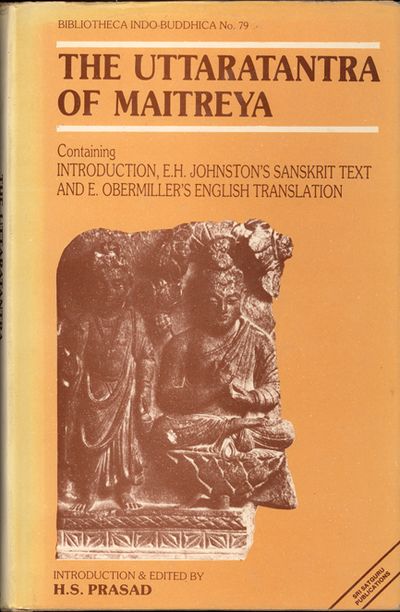- Acknowledgementsxiii
- (by H.S. Prasad)1
- 1 . The Development of the Gotra Theory2
- 2. The Mahāyāna Spiritual Discipline5
- 3. Gotra : The Foundation of Mahāyāna, and its Types9
- 4. The Characteristics of the Gotra12
- 5. The Gotra-based Classification of the Sentient Beings16
- 6. Notes19
- 7. Bibliography46
- 1. Introductory Note (by T. Chowdhury)53
- 2. Foreword (by E.H. Johnston)57
- 3. Abbreviations67
- 4. Corrections68
- 5. Chapter I : Tathāgatagarbhādhikāra69
- 6. Chapter II : Bodhyādhikāra147
- 7. Chapter III : Guṇādhikāra159
- 8. Chapter IV : Tathāgatakṛtyakriyādhikāra166
- 9. Chapter V : Anuśaṃsādhikāra183
- 10. Index of Metres188
- 11. Index of Authorities189
- 12. Index of Technical Terms190
- 13. Index of Rare Words and Uses197
- (by J. Takasaki)203
- I. The 5 Treatises of Maitreya and their Subject-matter21
- II. The Authorship of the Treatises of Maitreya222
- III. The Different Theories regarding the Fundamental Element or Germ of Enlightenment226
- a) The Term Gotra and its Interpretation in Hīnayāna227
- b) The Yogācāra Theories Concerning Dhātu or Gotra229
- IV. The Standpoint of the Mādhyamikas. The Teaching of the Element of Buddhahood according to the Uttaratantra234
- I. The Contents of the Work241
- The Explanation of the Verse by Āryāsaṅga242
- The 7 Subjects according to the Dhāraṇīśvara-rāja-paripṛcchā245
- The Germ of Buddhahood and the Other 3 Subjects according to the Dhāraṇīśvara-rāja-paripṛcchā249
- The Connexion between the 7 Subjects252
- The Jewel of the Buddha253
- Āryāsaṅga on the Jewel of the Buddha255
- Reference to the Jñāna-āloka-alaṃkãra-sūtra257
- The Jewel of the Doctrine261
- Reference to Scripture Concerning Extinction263
- The Path as the Cause of Extinction265
- The Jewel of the Congregation267
- The Saint’s Knowledge of the Absolute Truth268
- The Empirical Knowledge of the Saints270
- The Perception of the Saints is Introspective Knowledge271
- The Hīnayānistic Congregation is not Worthy of Being Worshipped 272
- The 3 Jewels in their Character of a Refuge273
- The Motives for the Establishment of the 3 Refuges from the Empirical Standpoint as Explained by Āryāsaṅga273
- The Doctrine and the Congregation are not Refuges in the Ultimate
Sense274 - The Buddha is the Unique Absolute Refuge276
- The Meaning of "The 3 Jewels"277
- The Germ, Enlightenment, the Attributes and the Acts of the Buddha in
their Inconceivable Nature278 - The Parable of the Cloth of Silk281
- The Acts of the Buddha in their Inconceivable Character283
- The Germ and the 3 other Subjects as a Causes and Conditions of Buddhahood285
- The Germ of the Absolute286
- Analysis of the Germ from 10 Points of View287
- The Essence of the Germ (1) and the Causes of its Purification (2)288
- The Impediments and the Causes of Purification289
- The Result of Purification (3) and the Functions of the Germ (4)294
- Concordance between the 4 Absolute Properties and the 4 Causes of Purification297
- The Impediments to the Attainment of the 4 Absolute Properties299
- Reference to Scripture302
- The Motives of the 4 Absolute Properties302
- The Functions of the Germ of the Buddha (4)305
- The Annihilation of the Germ is to be Understood in a Conventional
Sense307 - The Relations of Germ to the Factors and the Result of Purification (5)308
- Reference to Scripture311
- The Manifestations of the Germ (6)311
- The Different of the Germ (7)313


